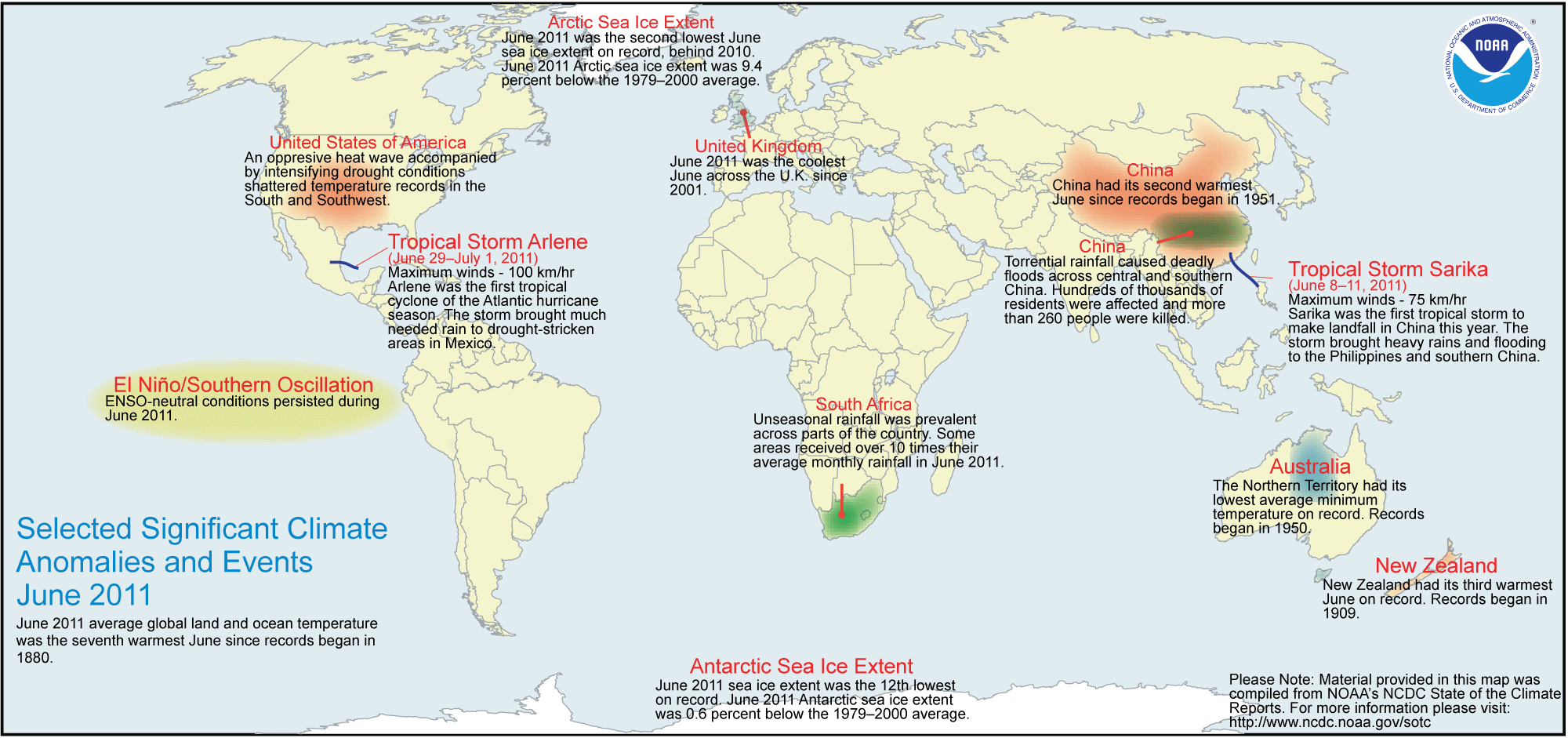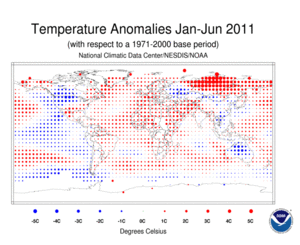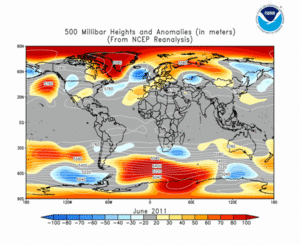Contents of this Section:
 June 2011 Selected Climate
June 2011 Selected Climate
Anomalies and Events Map
Global Highlights
- The combined global land and ocean average surface temperature for June 2011 was the seventh warmest on record at 16.08°C (60.94°F), which is 0.58°C (1.04°F) above the 20th century average of 15.5°C (59.9°F).
- June 2011 was the 316th consecutive month with a global temperature above the 20th century average. The last month with below-average temperature was February 1985.
- The June worldwide average land surface temperature was 0.89°C (1.60°F) above the 20th century average of 13.3°C (55.9°F)—the fourth warmest on record.
- The global average ocean surface temperature was the 10th warmest June on record, at 0.47°C (0.85°F) above average. Neither El Niño nor La Niña conditions were present during June 2011. According to NOAA's Climate Prediction Center, these ENSO-neutral conditions are expected to continue into the Northern Hemisphere fall 2011.
- The first half of 2011 (January–June) was the 11th warmest on record for the combined global land and ocean surface temperature. Separately, the worldwide average ocean temperature was also the 11th warmest January–June and the worldwide average land temperature was the 12th warmest such period.
Please Note: The data presented in this report are preliminary. Ranks and anomalies may change as more complete data are received and processed. Effective with the July 2009 State of the Climate Report, NCDC transitioned to the new version (version 3b) of the extended reconstructed sea surface temperature (ERSST) dataset. ERSST.v3b is an improved extended SST reconstruction over version 2. For more information about the differences between ERSST.v3b and ERSST.v2 and to access the most current data, please visit NCDC's Global Surface Temperature Anomalies page.
Introduction
Temperature anomalies for June 2011 are shown on the dot maps below. The dot map on the left provides a spatial representation of anomalies calculated from the Global Historical Climatology Network (GHCN) dataset of land surface stations using a 1961–1990 base period. The dot map on the right is a product of a merged land surface and sea surface temperature (SST) anomaly analysis developed by Smith et al. (2008). For the merged land surface and SST analysis, temperature anomalies with respect to the 1971–2000 average for land and ocean are analyzed separately and then merged to form the global analysis. For more information, please visit NCDC's Global Surface Temperature Anomalies page.
June
Warmer-than-average conditions dominated the globe during June 2011, with the most prominent warmth present across most of Russia, Europe, and China, the Middle East, eastern Canada, Mexico, and the southern United States. Cooler-than-average regions included the northern and western United States, part of western Canada, and most of Australia. The monthly average world land surface temperature anomaly of 0.89°C (1.60°F) was the fourth warmest June on record.
According to the China Meteorological Administration, June 2011 was the second warmest June for the country since records began in 1951. The temperature was 1.0°C (1.8°F) above the average of 19.5°C (67.1°F). The northwestern province of Gansu had its warmest June on record.
In the Southern Hemisphere, the National Institute of Water & Atmospheric Research reported that New Zealand had its third warmest June since records began in 1909, with the temperature 1.5°C (2.7°F) above the monthly average. However, temperatures in Australia remained below normal across most of the country during the month. According to Australia's Bureau of Meteorology, it was the eighth coolest average minimum temperature on record for June. The Northern Territory had its coolest average minimum temperature and also the eighth coolest average maximum temperature for June since records began in 1950. Australia reports average monthly maximum and minimum temperatures instead of general monthly averages.
The warmth across China contributed to the third warmest June average land temperature in the Northern Hemisphere. In contrast, the cooler-than-average temperatures in Australia contributed to the 19th warmest June average land temperature in the Southern Hemisphere.
Following the dissipation of La Niña in May, the worldwide average ocean surface temperature during June 2011 was 0.47°C (0.85°F) above the 20th century average—the 10th warmest June on record. The warmth was most pronounced across the central north Pacific, equatorial west Pacific, the Labrador Sea, the equatorial Atlantic, and much of the mid-latitude southern oceans. According to NOAA's Climate Prediction Center (CPC), neither El Niño nor La Niña conditions are likely to develop into the Northern Hemisphere fall 2011. Globally, the combined worldwide land and ocean surface temperature was the seventh warmest June since records began in 1880.
Year-to-date (January–June)
The  January–June 2011 map of temperature anomalies shows that, for the first half of the year, anomalous warm temperatures were present over much of the world, including most of Russia and Europe, Mexico, the southern and eastern United States, most of Alaska, and northwestern Africa. Cooler-than-average conditions prevailed over much of the northern United States, Southeast Asia, part of Kazakhstan and eastern Russia, northern Ukraine, and much of Australia. The combined global average land and ocean surface temperature for the January–June period was the 11th warmest such period on record. This value is 0.50°C (0.90°F) above the 20th century average. Separately, the average worldwide ocean surface temperature also ranked as the 11th warmest on record, while the worldwide average land surface temperature ranked as the 12th warmest January–June on record.
January–June 2011 map of temperature anomalies shows that, for the first half of the year, anomalous warm temperatures were present over much of the world, including most of Russia and Europe, Mexico, the southern and eastern United States, most of Alaska, and northwestern Africa. Cooler-than-average conditions prevailed over much of the northern United States, Southeast Asia, part of Kazakhstan and eastern Russia, northern Ukraine, and much of Australia. The combined global average land and ocean surface temperature for the January–June period was the 11th warmest such period on record. This value is 0.50°C (0.90°F) above the 20th century average. Separately, the average worldwide ocean surface temperature also ranked as the 11th warmest on record, while the worldwide average land surface temperature ranked as the 12th warmest January–June on record.
The average position of the upper-level ridges of high pressure and troughs of low pressure (depicted by positive and negative 500-millibar height anomalies on the  June 2011 map, respectively) are generally reflected by areas of positive and negative temperature anomalies at the surface, respectively. For other Global products, please see the Climate Monitoring Global Products page.
June 2011 map, respectively) are generally reflected by areas of positive and negative temperature anomalies at the surface, respectively. For other Global products, please see the Climate Monitoring Global Products page.
Images of sea surface temperature conditions are available for all weeks during 2009 from the weekly SST page.
Temperature Rankings and Graphics
| June | Anomaly | Rank (out of 132 years) | Warmest on Record | ||||
|---|---|---|---|---|---|---|---|
| °C | °F | Year | °C | °F | |||
| Global | |||||||
| Land | +0.89 ± 0.13 | +1.60 ± 0.23 | 4th warmest | 2010 | +1.05 | +1.89 | |
| Ocean | +0.47 ± 0.04 | +0.85 ± 0.07 | 10th warmest | 1998 | +0.59 | +1.06 | |
| Land and Ocean | +0.58 ± 0.07 | +1.04 ± 0.13 | 7th warmest | 2010 | +0.68 | +1.22 | |
| Northern Hemisphere | |||||||
| Land | +1.05 ± 0.15 | +1.89 ± 0.27 | 3rd warmest | 2010 | +1.20 | +2.16 | |
| Ocean | +0.45 ± 0.04 | +0.81 ± 0.07 | 12th warmest | 2009 | +0.62 | +1.12 | |
| Land and Ocean | +0.68 ± 0.09 | +1.22 ± 0.16 | 4th warmest | 2010 | +0.80 | +1.44 | |
| Southern Hemisphere | |||||||
| Land | +0.45 ± 0.12 | +0.81 ± 0.22 | 19th warmest | 2005 | +1.07 | +1.93 | |
| Ocean | +0.49 ± 0.04 | +0.88 ± 0.07 | 10th warmest | 1998 | +0.60 | +1.08 | |
| Land and Ocean | +0.48 ± 0.06 | +0.86 ± 0.11 | 11th warmest | 1998 | +0.63 | +1.13 | |
*Signifies a tie
| January–June | Anomaly | Rank (out of 132 years) | Warmest on Record | ||||
|---|---|---|---|---|---|---|---|
| °C | °F | Year | °C | °F | |||
| Global | |||||||
| Land | +0.77 ± 0.20 | +1.39 ± 0.36 | 12th warmest* | 2007 | +1.19 | +2.14 | |
| Ocean | +0.40 ± 0.04 | +0.72 ± 0.07 | 11th warmest | 1998 | +0.56 | +1.01 | |
| Land and Ocean | +0.50 ± 0.09 | +0.90 ± 0.16 | 11th warmest | 2010 | +0.70 | +1.26 | |
| Northern Hemisphere | |||||||
| Land | +0.93 ± 0.24 | +1.67 ± 0.43 | 11th warmest | 2007 | +1.37 | +2.47 | |
| Ocean | +0.37 ± 0.05 | +0.67 ± 0.09 | 10th warmest* | 2010 | +0.56 | +1.01 | |
| Land and Ocean | +0.58 ± 0.13 | +1.04 ± 0.23 | 9th warmest* | 2007 | +0.80 | +1.44 | |
| Southern Hemisphere | |||||||
| Land | +0.37 ± 0.16 | +0.67 ± 0.29 | 24th warmest* | 2005 | +0.95 | +1.71 | |
| Ocean | +0.43 ± 0.04 | +0.77 ± 0.07 | 11th warmest | 1998 | +0.60 | +1.08 | |
| Land and Ocean | +0.42 ± 0.07 | +0.76 ± 0.13 | 12th warmest* | 1998 | +0.65 | +1.17 | |
*Signifies a tie
* Global Land tied with 2001 as 12th warmest on record.
* Northern Hemishere Ocean tied with 2001 as 10th warmest on record.
* Northern Hemishere Land and Ocean tied with 2003 as 9th warmest on record.
* Southern Hemisphere Land tied with 1996 as 24th warmest on record.
* Southern Hemisphere Land and Ocean tied with 1999 as 12th warmest on record.
The most current data may be accessed via the Global Surface Temperature Anomalies page.
Precipitation
The maps below represent anomaly values based on the GHCN dataset of land surface stations using a base period of 1961–1990. Precipitation anomalies on a month-to-month basis are often highly variable across the globe and even within regions. The areas with the wettest anomalies during June 2011 included the Caribbean, South Africa, the Middle East, and western Mongolia. The driest anomalies were present across the southern United States, much of eastern Brazil, Argentina, and Peru.
According to the South African Weather Service, unseasonal rainfall was prevalent in some parts of the country during June. Many stations received more than 2 to 25 times their average monthly rainfall during June. Twelve stations across four states reported June rainfall amounts more than ten times higher than average.
Additional details on flooding and drought can also be found on the June 2011 Global Hazards page.
For additional details on precipitation and temperatures in June, see the Global Hazards page.
References
Peterson, T.C. and R.S. Vose, 1997: An Overview of the Global Historical Climatology Network Database. Bull. Amer. Meteorol. Soc., 78, 2837-2849.
Quayle, R.G., T.C. Peterson, A.N. Basist, and C. S. Godfrey, 1999: An operational near-real-time global temperature index. Geophys. Res. Lett., 26, 333-335.
Smith, T.M., and R.W. Reynolds (2005), A global merged land air and sea surface temperature reconstruction based on historical observations (1880-1997), J. Clim., 18, 2021-2036.
Smith, et al (2008), Improvements to NOAA's Historical Merged Land-Ocean Surface Temperature Analysis (1880-2006), J. Climate., 21, 2283-2293.
 NOAA's National Centers for Environmental Information
NOAA's National Centers for Environmental Information







